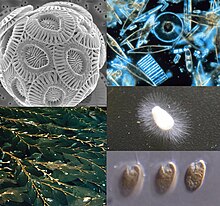Halvaria
| Halvaria | |
|---|---|

| |
| Clockwise from top-left: a haptophyte, some diatoms, a water mold, a cryptomonad, and Macrocystis, a phaeophyte. The diatoms, water mold, and Macrocystis are halvarians. | |
| Scientific classification | |
| Domain: | Eukaryota
|
| (unranked): | Bikonta
|
| (unranked): | |
| (unranked): | Halvaria* Cavalier-Smith, 2010
|
| Phyla | |
| |
Halvaria is a grouping that includes Alveolata and Heterokonta (Stramenopiles).[1]
Analyses in 2007 and 2008 agree that the Stramenopiles and the Alveolata are related, forming a reduced chromalveolate clade. They group together with the Rhizaria (originally one of the six major eukaryote groups) to form a clade dubbed the SAR supergroup.[2][3][4]
A phylogenomic analysis published in 2016 casts doubt on Halvaria, suggesting that Alveolata is the sister group to Rhizaria (the R + A clade) within the SAR supergroup. According to this study, which incorporates new rhizarian sequence data, support for the Halvaria grouping might be an artifact of low taxon sampling as well as long branch attraction.[5]
See also[]
References[]
- ^ Cavalier-Smith T (June 2010). "Kingdoms Protozoa and Chromista and the eozoan root of the eukaryotic tree". Biol. Lett. 6 (3): 342–5. doi:10.1098/rsbl.2009.0948. PMC 2880060. PMID 20031978.
- ^ Fabien Burki; Kamran Shalchian-Tabrizi; Marianne Minge; Åsmund Skjæveland; Sergey I. Nikolaev; Kjetill S. Jakobsen; Jan Pawlowski (2007). "Phylogenomics Reshuffles the Eukaryotic Supergroups". PLOS ONE. 2 (8): e790. doi:10.1371/journal.pone.0000790. PMC 1949142. PMID 17726520.

- ^ Burki, Fabien; Shalchian-Tabrizi, Kamran & Pawlowski, Jan (2008). "Phylogenomics reveals a new 'megagroup' including most photosynthetic eukaryotes". Biology Letters. 4 (4): 366–369. doi:10.1098/rsbl.2008.0224. PMC 2610160. PMID 18522922.
- ^ Kim, E; Graham, LE (Jul 2008). "EEF2 analysis challenges the monophyly of Archaeplastida and Chromalveolata". PLOS ONE. 3 (7): e2621. doi:10.1371/journal.pone.0002621. PMC 2440802. PMID 18612431.

- ^ He, Ding; Sierra, Roberto; Pawlowski, Jan; Baldauf, Sandra L. (2016-08-01). "Reducing long-branch effects in multi-protein data uncovers a close relationship between Alveolata and Rhizaria". Molecular Phylogenetics and Evolution. 101: 1–7. doi:10.1016/j.ympev.2016.04.033. PMID 27132173.
Categories:
- SAR supergroup unranked clades